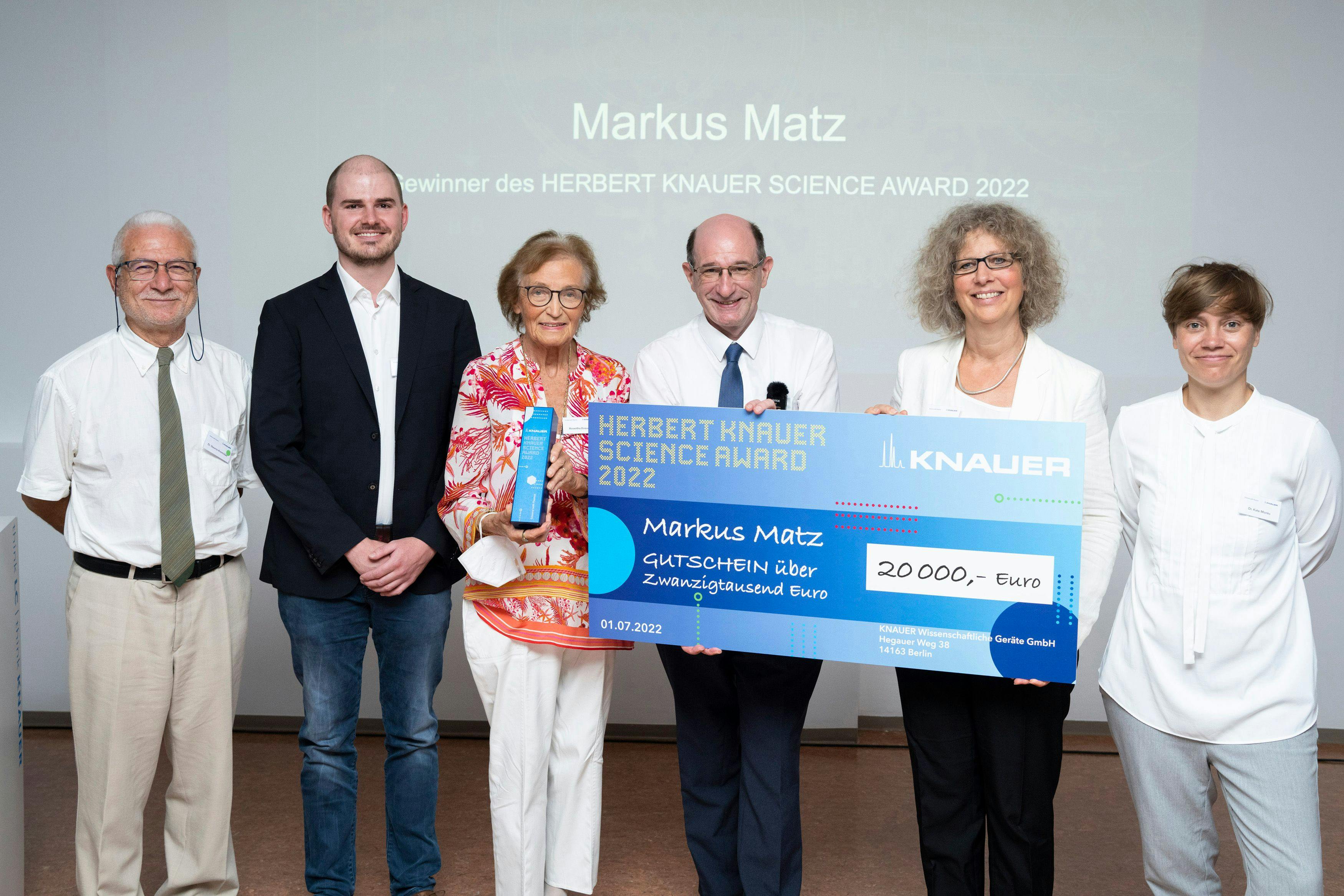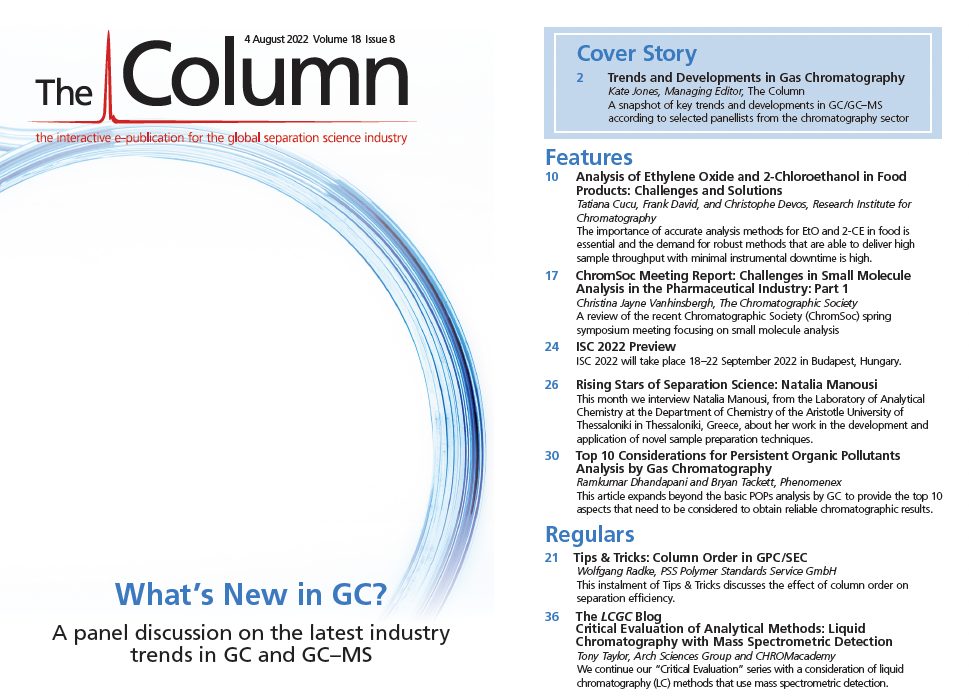Trends and Developments in Gas Chromatography
A snapshot of key trends and developments in gas chromatography/gas chromatography–mass spectrometry (GC/GC–MS) according to selected panellists from the chromatography sector.
Q. What trends do you see emerging in GC or GC–MS?
Alessandro Baldi Talini: The major trends for gas chromatography (GC) and GC–mass spectrometry (GC–MS) in laboratories right now can be found in the features of the Industry 4.0 era, which includes digitalization and smart and automated technologies fuelled by data and machine learning. In pre‑pandemic times, interest in the benefits of smart and automated technologies was high. With the necessity to protect people and also keep science and business going during the pandemic, however, the new normal of social distancing, working from home (WFH), hybrid working shifts, and labour shortages have greatly accelerated the adoption and implementation of digitalization. For laboratories it has become very important to integrate new ways of operational efficiency. Remoteness and connectivity of GC workflows will be lasting trends.
Sustainability, from an environmental and operational perspective, is another topic that is seeing a lot of interest. For example, given supply chain dependencies, disruptions, and rising costs coming from world events, the use of helium is shifting to less costly and greener alternatives. The use of hydrogen generators is a perfect example of how technology can address sustainability and market shifts. There is no handling of gas tanks, no shipments, you never run out of gas, and water generates a carrier that facilitates fast and safe chromatography.
James Gearing: One emerging trend is the focus on sustainability and the strive for more efficient laboratory operations. Instrument design and manufacturing is taking sustainability into consideration,
from product inception to decommissioning and disposal. Everything from materials chosen, manufacturing processes, and shipment are evaluated. Many instruments now have environmental impact scores to help enterprises make informed decisions when it comes to sustainability.
Another trend is the strong interest in alternative carrier gases, particularly switching from helium to hydrogen due to increased helium costs and shortages. System features also contribute to the sustainability goals of the laboratory, for example, gas saver and direct column heating ovens reduce gas and power usage. In the area of sample introduction and sample preparation, the trend is towards more automation, with popular techniques such as headspace, purge and trap, and thermal desorption. Pyrolysis extends the range of GC, opening up new application areas. Full sample characterization with fast GC is driving more class‑based analysis. New regulations for environmental applications, dioxins, and genotoxic impurities are driving new waves of adoption of GC–MS.
Hansjoerg Majer: While relaxing at home, I like to watch the old forensic TV series such as Medical Detectives. I am amazed at how the new and innovative technology “gas chromatography” is often celebrated as solving the case. Forty years later, some consider the technology mature, pointing to the recently added light inside the GC oven as the latest innovation.
Scientists and technicians use gas chromatography daily to solve their challenges. For the manufacturers of chromatography systems, the column remains the centrepiece.
Technical expertise in chromatography may be decreasing; however, the complexity of the test and sample load is increasing. Gas chromatography has become the workhorse, and the focus is on the robustness of the process. Equipment and consumables are expected to operate 24/7. Instruments are found in high‑throughput routine laboratories, production facilities, glove boxes, ocean‑going research vessels, and in space. The European Space Agency’s Rosetta mission put columns on the Philae lander to sample the comet surface.
There is a clear trend towards faster processes and miniaturization. The combination of gas chromatography with newer, smaller detectors, such as ion mobility spectroscopy (IMS), makes “handheld” systems seem possible for complex applications such as food safety or environmental protection.
Old and new approaches to chromatography have taken advantage of the rapid increase in instrument sensitivity and acquisition speed. For example, low‑pressure GC (LPGC) decreases runtimes by decreasing the elution temperature of compounds in a vacuum—a technology that has existed for many years but has been reinvented now.
On the other hand, new technology such as flow-field thermal gradient GC (FF-TG-GC) allows precise control of the temperature and thermal gradient, producing narrower peak widths and faster runtimes.
Big data handling capacities will give more complex systems like two‑dimensional gas chromatography (GC×GC) another chance to enter the routine analysis area.
Massimo Santoro: While GC is still widely used for very common applications, it’s interesting to see its use gaining ground to complement the information needed for challenging applications that can’t be addressed exclusively with other techniques. I’m referring to the increased interest in volatile per- and polyfluoroalkyl compounds (PFAS), where GC–MS with sample introduction by thermal desorption is used alongside liquid chromatography (LC)/LC–MS for its capacity to investigate volatile species that would simply be missed otherwise, or when GC–MS is used alongside spectroscopic techniques for quantitative determination of microplastics in water, air, and materials.
Q. What is the future of GC or GC–MS?
Alessandro Baldi Talini: The future for GC and GC–MS lies in implementing the Industry 4.0 blueprint by looking at: how labs can become digitally-enabled by being connected and allowing remote work; how automation can be integrated into repetitive tasks, enabling lab staff to be more focused on data analysis and insightful action; and how GC, GC–MS, and chromatography data systems (CDS) can mitigate training and adoption costs for new technologies by considering new “digital skills” of lab staff, driven by the spread of digital devices.
James Gearing: The recent introductions of smart and connected intelligent instruments has set the path for the future. Containing powerful microprocessors, GC and GC–MS systems will continue to be enhanced with even more advanced algorithms and capabilities to eliminate routine operator tasks, simplifying diagnostics and troubleshooting, and with software systems automating data review with artificial intelligence (AI) and machine learning. Analysis is being driven closer to the sampling location with mobile, remote, at-, or near-line applications, especially with micro-GC. For example, reaction gas monitoring is growing as alternative fuel research is increasingly funded. Instruments are becoming more self-aware and can perform analysis in the background and alert users of exceptions requiring attention.
Hansjoerg Majer: Rapid on-site screening of chemicals continues to advance with the miniaturization of mass spectrometers and other detectors. For example, ion trap mass spectrometry (IT-MS) systems measure only around 1 mm in diameter. There are portable GC–MS systems with a low thermal mass (LTM) column that weigh only about 15 kg and produce similar data to a benchtop system. Chemical sensor technology incorporates multiple detectors on a chip and customized polymers coated onto a sensor platform targeting compounds with different polarities/solubilities that can be analyzed from the atmosphere in real-time.
Massimo Santoro: They have a bright future. Most of the common emerging contaminants are very volatile species, for which GC and GC–MS are the ideal choices. Additionally, technological advances in sampling techniques, sample introduction, and MS detection have meant that entire workflows can be miniaturized, reducing sample and solvent waste, moving away from the use of non-renewable helium as carrier gas, and making GC and GC–MS more environmentally friendly.
Q. What is the GC or GC–MS application area that you see growing the fastest?
Alessandro Baldi Talini: There is an expansion of GC and GC–MS applications in growing industries, in particular, batteries and recycled polyethylene terephthalate (PET). It will be interesting to see the adoption of well‑established methods, slightly modified, to accommodate the need of these new types of samples.
James Gearing: There is a shift in focus towards renewable fuels and a growing need to expand hydrocarbon composition testing capabilities to better understand these molecules. GC×GC is receiving growing attention as a potential all‑in‑one fuel composition analyzer with the proliferation of low footprint non‑cryogenic flow modulation technology. While conventional fuel product quality focuses primarily on physical property and performance‑based testing, renewable molecules are being qualified as fuel blend components initially by composition. Synthetic paraffinic kerosenes (SPKs) are an example of renewable fuels that currently require “per-batch” analysis of molecular classes by pre-fractionation and GC–MS. GC×GC provides the same analytical fidelity without cumbersome sample preparation, and the initial GC×GC consensus test methods are targeting SPK fuels. This lays the foundation for GC×GC to potentially consolidate existing conventional fuels composition testing, currently spread between high performance liquid chromatography (HPLC), supercritical fluid chromatography (SFC), GC, and GC–MS, into a single platform.
Hansjoerg Majer: In North America, cannabis testing has expanded from pesticides to terpene characterization.
Food fraud detection and food quality control via fingerprinting and data handling is an emerging topic.
Nitrosamines have taken centre stage globally as an impurity in medications, but they are also found in the environment, food, beverages, cosmetics, and cigarette smoke; these compounds are strong carcinogens and have garnered worldwide attention.
Persistent organic pollutants (POPs), which are known by many other acronyms (persistent mobile organic compounds [PMOC]; persistent, mobile, toxic [PMT]), will continue to garner attention and funding for research and future regulation. These compounds include legacy compounds as well as emerging compounds of interest.
In addition, there is a clear trend to combine methods into so-called multi‑multi‑methods. These are screening methods in which different component classes are combined. Such methods place high demands on the tuning of separation column selectivity.
Nontarget screening is another methodological approach that is dependent on the newest big data handling capacities, and will become more popular in different areas of interest such as environmental or food analysis.
Massimo Santoro: I would say every application that has an impact on human health is going to grow fast in the coming years. From environmental applications looking for emerging contaminants to food quality/food adulteration, all the way to monitoring the air we breathe in and out—GC–MS is the technique of choice for early diagnostics of diseases. Most of these applications didn’t exist 10–15 years ago, or were not as challenging for GC–MS in terms of sensitivity and throughput requirements. Now every result has to be provided in a timely manner, and that offers another chance for GC–MS robustness to shine.
Q. What obstacles stand in the way of GC or GC–MS development?
Alessandro Baldi Talini: Rather than focus on obstacles, I would refer more to opportunities when we develop new GC platforms. Laboratories are looking more than ever for ease of use and predefined workflows to minimize time to data and to be able to easily adopt new applications. The challenge is to be able to provide a user experience similar to what we all expect every day when interacting with our mobile devices, computers, and cars. The commoditization of GC technology calls for intuitiveness, interactive/updated graphics, fast data access, and easy collaboration, making the experience and the data the focus vs. the actual instrument and technology working behind the scenes.
James Gearing: GC/GC–MS systems serve a broad range of markets and application areas, often with long time frames of historical data and workflows. It requires compelling business justification to modify existing methods or workflows. For example, the recurring shortages of helium and increased costs are driving a change towards hydrogen-based methods. GC and GC–MS users are also facing ever‑increasing measurement demands because of new regulations or stricter quality assurance/quality control (QA/QC) product requirements. Broader use of tandem mass spectrometry (MS/MS) or GC×GC, along with more advanced software processing, could help simplify the overall workflow and deliver actionable results.
Hansjoerg Majer: Gas chromatography is dependent on the carrier gas. Over many years helium has proven to be particularly suitable, both because of its inertness in the chromatographic system and because of its properties in the ionization sources of mass spectrometric detectors.
From time to time, we are reminded that helium is not always available in unlimited quantities. As a result, some analytical methods have to be switched to other carrier gases, such as nitrogen or hydrogen, especially when information has to be delivered without interruption.
Nowadays, such conversions can be accompanied by computer programs, but they are not without risks.
The so-called “big markets” in analytics, namely, the pharmaceutical sector with its trend towards large biological molecules, makes instrument providers more likely to invest in the LC sector, so innovations in the GC sector may not progress as fast as they could.
Massimo Santoro: None, really. I think there will always be a need for GC–MS to be adopted more widely, and that’s an excellent opportunity for developing smaller, smarter, more integrated GC–MS solutions.
Q. What was the biggest accomplishment or news in 2021/2022 for GC or GC–MS?
Alessandro Baldi Talini: The most relevant news of 2021 has been the
return of strong market demand. Although the pandemic is still hitting some market areas, we have seen the market going back to 2019 levels pretty much in every segment. With that, we have seen a profound change in demand, with a large focus on remote capabilities and for technologies that foster collaboration across teams.
James Gearing: A new GC–MS ion source allows the wider use of hydrogen as a carrier gas in GC–MS applications. As I mentioned before, we see a continued acceleration of users adopting hydrogen as a carrier gas. Due to hydrogen not possessing the same inert qualities as helium, this can pose a challenge, especially in the high energy environment of a GC–MS ion source. The new ion source greatly reduces the potential reaction between susceptible analytes and the hydrogen carrier gas.
A big accomplishment has been the continued development of smart-connected technology. New intelligent instrument features based on chromatographic data enable more advanced diagnostics, trending, and troubleshooting. Remote interfaces allow laboratory users more flexibility, resulting in less unplanned downtime and more efficient operations.
Hansjoerg Majer: The expansion of both FF-TG-GC and LPGC substantially increases sample throughput and can take advantage of the recent advances in mass spectrometer technology, that is, benchtop (BT)-TOF, orbital traps).
Massimo Santoro: Thermal desorber systems independently certified for the use of hydrogen carrier gas while still maintaining compatibility with conventional carrier gases such as helium and nitrogen are an important technological advancement. These can increase productivity by as much as
40–50% compared to the use of helium.
Alessandro Baldi Talini is Director Product Portfolio – Gas Chromatography at PerkinElmer, Inc.

James Gearing is Associate Vice President, Marketing Gas Phase Separations Division at Agilent Technologies, Inc.

Hansjoerg Majer is Senior Business Development Manager Europe at Restek.
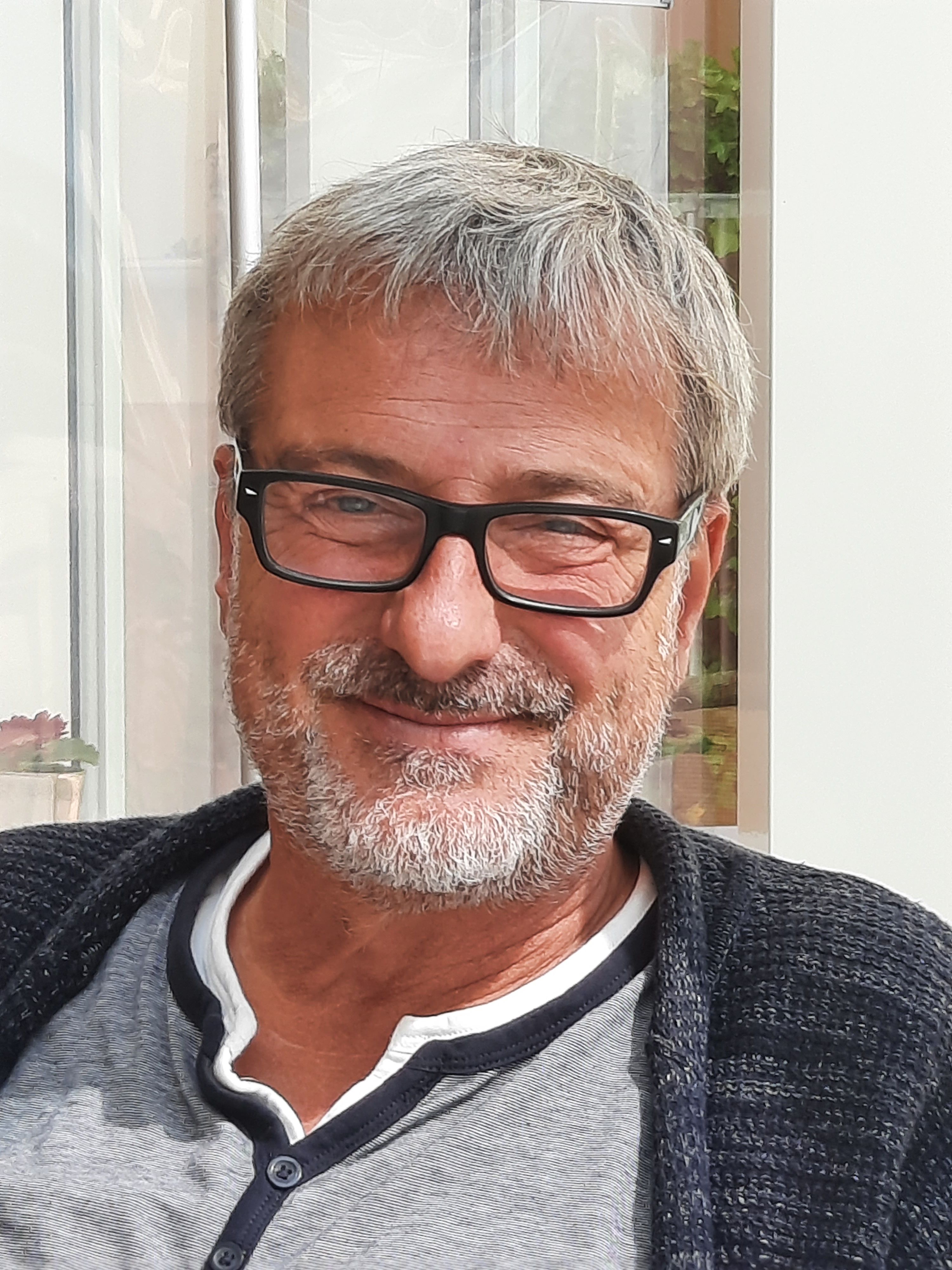
Massimo Santoro is Director of Business Development for Schauenburg Analytics and Markes International.
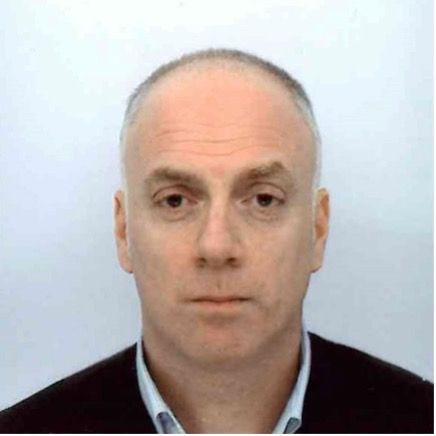
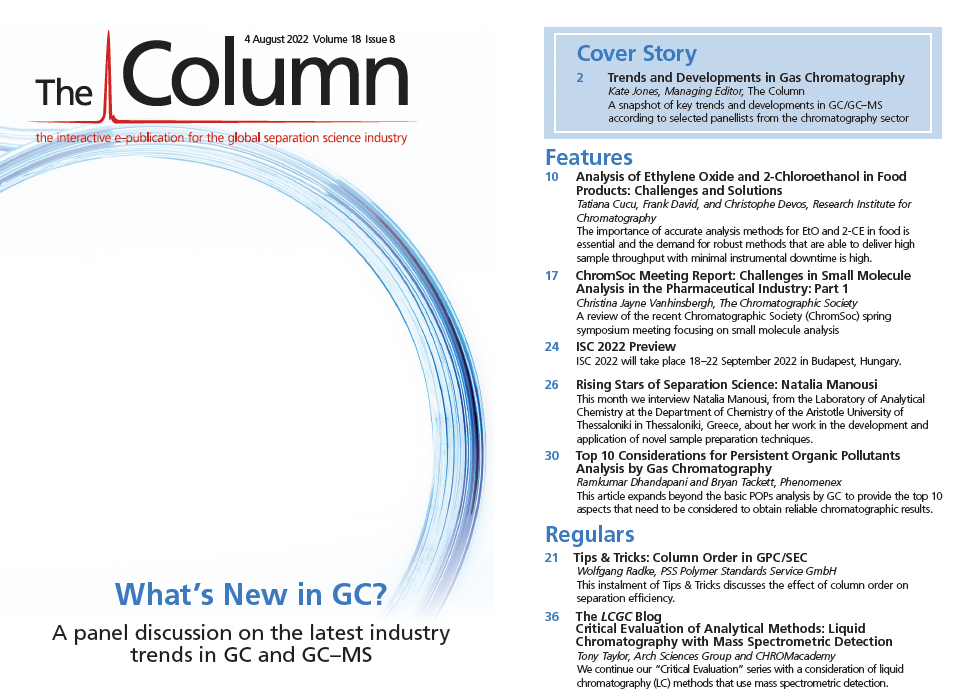
Common Challenges in Nitrosamine Analysis: An LCGC International Peer Exchange
April 15th 2025A recent roundtable discussion featuring Aloka Srinivasan of Raaha, Mayank Bhanti of the United States Pharmacopeia (USP), and Amber Burch of Purisys discussed the challenges surrounding nitrosamine analysis in pharmaceuticals.
Silvia Radenkovic on Building Connections in the Scientific Community
April 11th 2025In the second part of our conversation with Silvia Radenkovic, she shares insights into her involvement in scientific organizations and offers advice for young scientists looking to engage more in scientific organizations.

.png&w=3840&q=75)

.png&w=3840&q=75)



.png&w=3840&q=75)



.png&w=3840&q=75)









